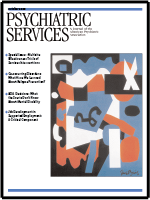During a recent discussion in which we juxtaposed two observations, my colleagues and I experienced a painful recognition. On one hand, longitudinal studies of individuals with a dual diagnosis—that is, co-occurring severe mental illness and substance abuse—in New Hampshire, Connecticut, Chicago, and Washington, D.C., were showing that the modal course of substance use disorder was characterized by fluctuating remissions and relapses. Even after months of stable remission, a large proportion of these individuals relapsed. Thus the emerging finding was that a majority of clients with dual diagnoses spent years in the relapse prevention phase of substance abuse treatment. On the other hand, updated reviews of intervention research on the population of persons with dual diagnoses—there are now more than 30 recent controlled trials—revealed many studies of the stages of engagement, motivation, and initiation of remission but no studies of relapse prevention. In other words, as clinical and services researchers, we have overemphasized the early stages of substance abuse treatment and neglected the long-term course of the disorder. In a more generous frame, now that we know that we can help people attain full remission, we need to expand our efforts to help them sustain that remission.
After confirming this startling and embarrassing insight with other researchers, we decided to take a serious look at relapse and relapse prevention in this population. We asked several dual diagnosis researchers—qualitative as well as quantitative researchers—to examine relapse of substance use disorder and relapse prevention in their study groups, based on research funded from various federal and other sources. In July 2003, Dartmouth Medical School hosted a day-long conference, which included consumers, family members, clinicians, and mental health administrators as well as researchers.
The articles in this special section of Psychiatric Services represent the findings from that conference. The first article, by Mark P. McGovern, Ph.D., and his colleagues, summarizes the theory and empirical research on relapse prevention in the general population of persons with substance use disorder. The next two articles, by Haiyi Xie, Ph.D., and colleagues and Angela L. Rollins, Ph.D., and colleagues, offer quantitative perspectives on predicting relapse of substance use disorder among clients with dual diagnoses who appear to be in stable remission. The next two articles—by Kristin E. Davis, Ph.D., and Sheila J. O'Neill, L.C.S.W., and by Maxine Harris, Ph.D., and her colleagues—provide qualitative views of relapse. As expected, the quantitative studies identify more distal and fixed risk factors, whereas the qualitative studies permit a more proximal and dynamic view. In the final article, my colleagues and I attempt to distill the findings and draw inferences for future studies in this area. Other presentations from the conference were omitted because they overlapped with the findings presented in these articles, were considered too preliminary by their presenters, or had already been submitted or published elsewhere.
The remarkable convergence among these preliminary studies—despite enormous differences in geographic regions, clinical populations, and research methods—suggests some measure of validity. The data indicate that relapse and relapse prevention for clients with co-occurring disorders, although similar in some ways to the phenomena in the general substance use disorder population, are also different and uniquely challenging.
My hope is that these articles will convey the critical importance of the topic and will suggest new approaches to clinicians and researchers. Certainly all the stakeholders who attended the Dartmouth conference were energized. Consumers confirmed that the researchers were on the right track: recovery is a long-term process that involves much more than attaining remission and presents a major personal challenge over many years. Administrators, clinicians, and researchers agreed that they should expand their short-term—and often narrowly focused—perspectives. The Dartmouth conference spawned larger conferences in Chicago in August 2004 and in Washington, D.C., in January 2005, both of which emphasized the need to develop creative approaches to interventions for this population. As a group of authors, we look forward to innovation in this area and hope that others are similarly challenged to do more to promote long-term outcomes for a still neglected and underserved population.

